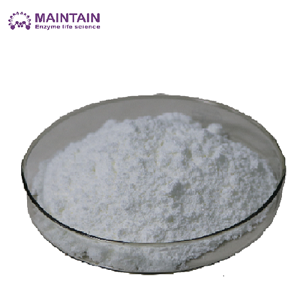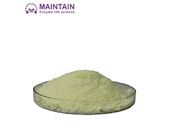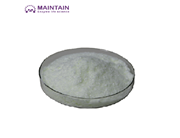| Nicotinamide adenine dinucleotide(NAD) powder (53-84-9) |
| NAD+ is an essential coenzyme required for life and cellular functions. Enzymes are catalysts that make biochemical reactions possible. Coenzymes are ‘helper’ molecules that enzymes need in order to function. |
|
|
| Name | β-Nicotinamide adenine dinucleotide (NAD) powder |
| CAS | 53-84-9 |
| EC Number: | 200-184-4 |
| Purity | 98% |
| Chemical name | beta-Diphosphopyridine nucleotide |
| Synonyms | Cozymase, β-NAD, β-DPN, DPN, Diphosphopyridine nucleotide, β-Nicotinamide adenine dinucleotide hydrate, NAD, Coenzyme 1, Nadide |
| Molecular Formula | C21H27N7O14P2 |
| Molecular Weight | 663.4 g/mol |
| Melting Point | 160 °C (320 °F; 433 K) |
| InChI Key | BAWFJGJZGIEFAR-NNYOXOHSSA-N |
| Form | Solid (lyophilized or crystalline powder) |
| Appearance | White powder |
| Solubility | Soluble in water (100 g/l) at 20° C. |
| Use | Cosmetic,Dietary Supplement,IVD ,biocatalysis (enzymatic synthesis) |
| Testing Document | Available |
| Bulk Density | 1.5-7g/ml |
| Particle size | >80 mesh |
| Storage Condition | Keep dry ,away from light, and store at 2℃- 8℃, long term store at -15℃ to -25℃ |
| Package | 10gram/bag ,50gram/bag , 1KG/bag, 25KG/drum |
| Application | β-Nicotinamide adenine dinucleotide (NAD+) and β-Nicotinamide adenine dinucleotide, reduced (NADH) comprise a coenzyme redox pair (NAD+:NADH) involved in a wide range of enzyme catalyzed oxidation reduction reactions. In addition to its redox function, NAD+/NADH is a donor of ADP-ribose units in ADP-ribosylaton (ADP-ribosyltransferases; poly(ADP-ribose) polymerases ) reactions and a precursor of cyclic ADP-ribose (ADP-ribosyl cyclases). |
| Greener alternative product characteristics | Waste Prevention |
| Less Hazardous Chemical Syntheses |
| Safer Solvents and Auxiliaries |
| Design for Energy Efficiency |
| Use of Renewable Feedstocks |
| Inherently Safer Chemistry for Accident Prevention |
| Learn more about the Principles of Green Chemistry. |
|
|
| DESCRIPTION |
|
| General description |
|
| Nicotinamide adenine dinucleotide (NAD) is a cofactor containing an adenylic acid and a nicotinamide-5′-ribonucleotide group linked together by a pyrophosphate moiety. It is ubiquitously found. In NAD+ complexes, the enzyme-cofactor interactions are highly conserved. |
| Application |
|
| NAD has been used in boiled-blood agar plate as a supplement for the growth of Actinobacillus pleuropneumoniae colony. |
| Biochem/physiol Actions |
|
| Nicotinamide adenine dinucleotide (NAD) acts as an electron carrier and significantly participates in enzyme-catalyzed oxido-reduction processes and many genetic processes. NAD cycles between the oxidized (NAD+) and reduced (NADH) forms to maintain a redox balance necessary for continued cell growth. This cofactor is also involved in microbial catabolism. β-NAD acts as a substrate for various enzymes in several cellular processes. |
| Electron acceptor |
|
| Packaging |
|
| Packaged by solid weight. |
| Quality |
|
| Absence of contaminants: LDH inhibitors are not detectable. |
| Organic solvents: <0.5% (GC) |
| Preparation Note |
|
Storage conditions (working solution): An aqueous solution in a concentration of 10 mg/ml (pH 2.5 to 3) maintains > 99% of its NAD content after 8 weeks of storage at 2 to 8 °C.
The stability of an aqueous solution in a concentration of 40 mg/ml is not expected to differ from that of a solution in a concentration of 10 mg/ml.
An aqueous solution in a concentration of 50 mg/ml (pH 2.0) maintains 97% of its NAD content after 2 days, 94% after 6 days and 91% after 10 days of storage at 2 to 8 °C and about 83% after 10 days of storage at 33 °C.
An aqueous solution in a concentration of 1.38 mg/ml shows a decrease of NAD content of 4% after 8 weeks of storage at 2 to 8 °C, stored at -15 to -25 °C the stability is expected to be > 6 months. A solution of NAD in triethanolamine buffer (pH 5.0) maintians 90% of its NAD content after
10 days of storage at 2 to 8 °C and 80% after 10 days of storage at 33 °C. |
| Analysis Note |
|
| ß-Nicotinamide adenine dinucleotide hydrate cofactor (NAD) has been used in an experimental protocol, done in order to mimic the citric acid cycle on an carbon electrode, in order to increase biofuel cell energy density. |
| Absorbance coefficients: 17.6 x 103 l x mol-1 x cm-1 at 260 nm, 5.9 x 103 l x mol-1 x cm-1 at 333 nm (CN complex) |


 China
China

